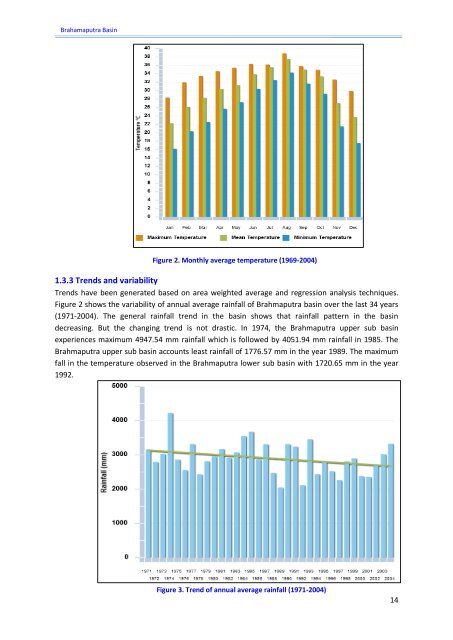Brahamaputra Basin
Create successful ePaper yourself
Turn your PDF publications into a flip-book with our unique Google optimized e-Paper software.
<strong>Brahamaputra</strong> <strong>Basin</strong><br />
1.3 Climate<br />
The basin experiences four distinct seasons in a year : winter, summer, monsoon and autum/postmonsoon.<br />
The winter season begins in December and continues to the end of February. In the high altitude<br />
places of Arunachal Pradesh and Sikkim, winter lasts longer-from November to March. Light northeasterly<br />
winds blow down the Brahmaputra valley in Assam and light northerly to north westerly<br />
winds in West Bengal. The weather is occasionally changed by the passage of western disturbances<br />
across the region, light rainfall occurs in January and February along the hills, increasing towards<br />
North-east Assam. Thunder storms are rare in December and January and occur only on one or two<br />
days in February, these may occasionally be accompanied by a dust or hail storm.<br />
From March onwards, the hot weather starts and continues up to the last week of May. In this<br />
season the basin is under the sway of three air streams a deep north-westerly current from Uttar<br />
Pradesh and Bihar, a shallow southerly stream from the head of the Bay of Bengal over the Orissa<br />
and Bengal coasts, and a shallower current of North easterly to easterly winds from the<br />
Brahmaputra valley blowing over the plains of North Bengal and Bihar. With the interactions<br />
between these air streams, this is a season when marked instability develops in the atmosphere and<br />
severe thunderstorms occur extensively, sometimes preceded by dust-raising squalls. Rainfall<br />
increases both in amount and frequency as the season advances, being generally associated with<br />
afternoon or evening thunderstorms and squalls. They are generally more concentrated in Upper<br />
Assam. Hail storms occur on one to three days in the season, especially in the Assam hills. The<br />
humidity is relatively high.<br />
The monsoon sets in by the last week of May or in early June, being usually ushered in by a<br />
depression in the Bay of Bengal. Subsequently, a series of such depressions, forming at the head of<br />
the Bay and moving inland, give spells of continuous and moderate to heavy rain generally over the<br />
region. July and August are the rainiest months. Almost all the rain in this season is associated with<br />
thunder.<br />
The monsoon withdraws in the last week of September or the first week of October. After the<br />
withdrawal of the monsoon winds, light unsteady winds are experienced by the middle of October.<br />
Occasionally, in October, cyclonic storms from the Bay cross the Bengal coast bringing clouds and<br />
rain with them.The weather during the autumn remains very comfortable with relatively clear sky<br />
and moderate temperature. On average these two months experience 3% to 6% of the average<br />
annual rainfall.<br />
1.3.1 Rainfall<br />
The distribution of rainfall in the Brahmaputra basin is different at different parts of the basin.<br />
Monsoon rains from June to September account for 60-70 % of the annual rainfall in the basin, while<br />
the premonsoon season covering the period March through May produces 20-25 % of the annual<br />
rainfall caused primarily by depressions moving from the west and by local convectional storms.<br />
During the post-winter months, the north-east monsoon finds its way into the Brahmaputra valley<br />
through a saddle in the high Himalayas, at their eastern end. The Assam range of hills gradually rises<br />
in height eastward from 300 m in the Garo hills to about 3,000 m in the Naga Hills. The low clouds<br />
brought in by the south-west monsoon get interrupted on the southern face of the Khasi and Jaintia<br />
hills by a 1,830 m high ridge and cause extremely heavy rainfall along the Cherrapunji-Mawphlang-<br />
11


